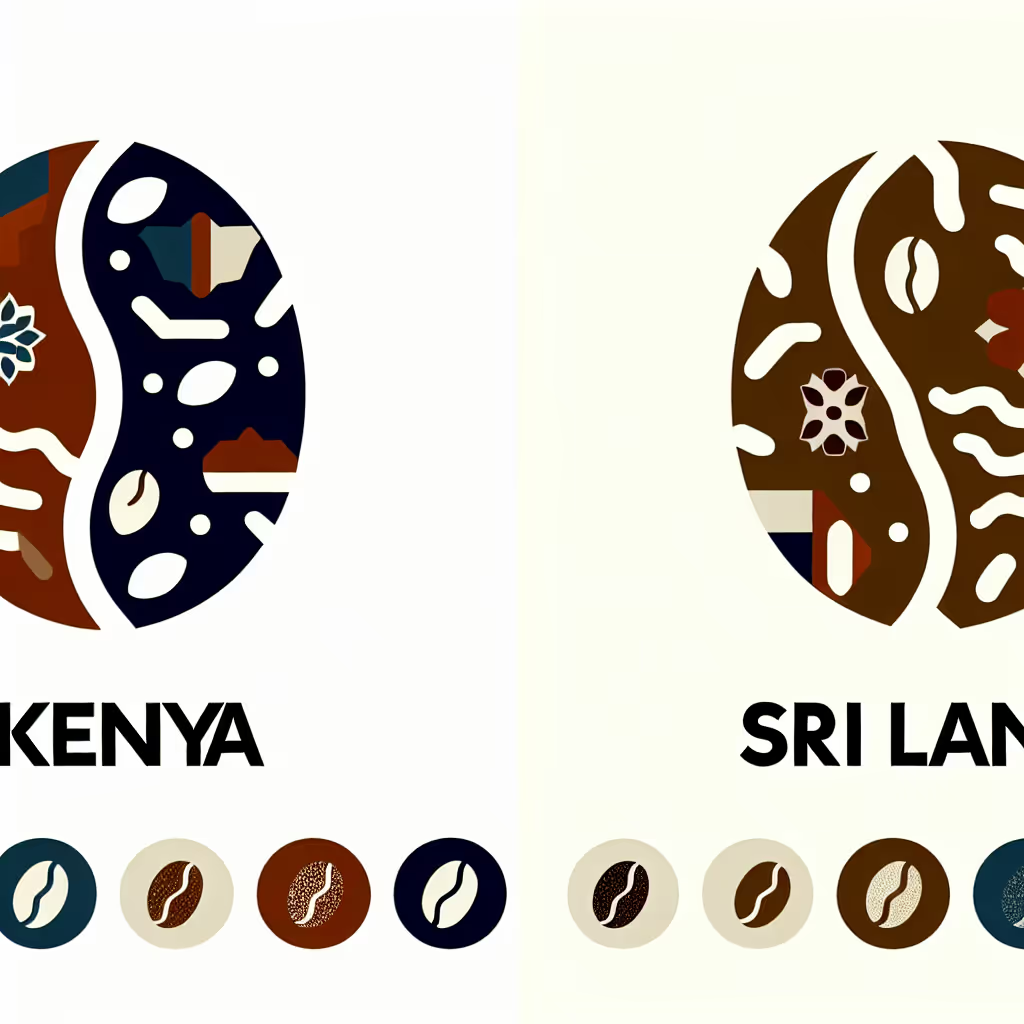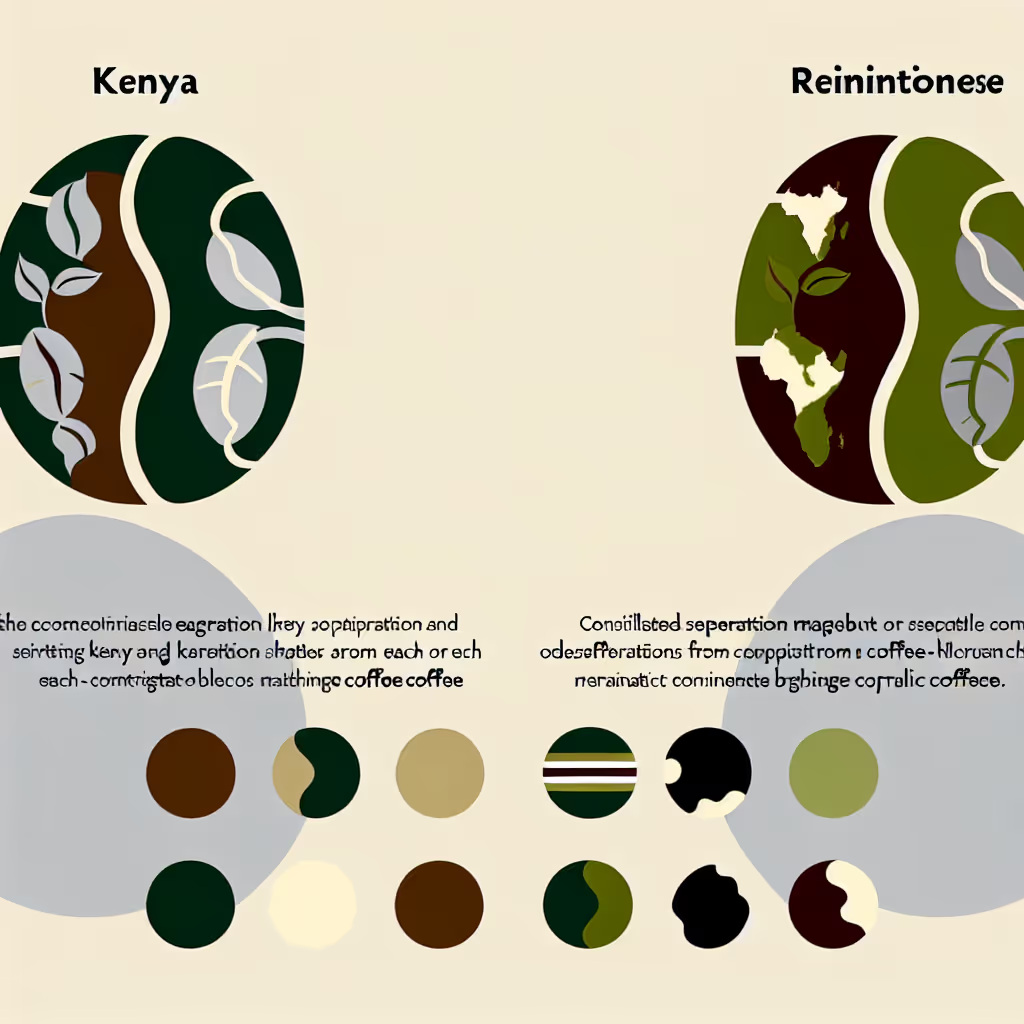Kenyan Vs. Sri Lankan Coffee
This comparison explores the unique qualities of Kenyan and Sri Lankan coffee, highlighting their distinct flavor profiles, growing conditions, and cultural significance in the world of specialty coffee.

Brief Description
Kenyan coffee is renowned for its bright acidity, full body, and complex flavor profile. Grown in the rich volcanic soils of the Central Highlands, these beans benefit from ideal climate conditions and meticulous processing. The result is a cup that's bold, wine-like, and often described as the 'connoisseur's choice'. With notes ranging from blackcurrant to citrus, Kenyan coffee offers a truly unique and memorable tasting experience.
Sri Lankan coffee, also known as Ceylon coffee, is a hidden gem in the world of specialty coffee. Grown in the lush Central Highlands, these beans offer a unique flavor profile that reflects the island's rich biodiversity. With a history dating back to the 19th century, Sri Lankan coffee has faced challenges but is now experiencing a revival, captivating coffee enthusiasts with its distinctive taste and aromatic qualities.
Importance of Comparison
Comparing Kenyan and Sri Lankan coffee is crucial for coffee enthusiasts seeking to expand their palate and understand the nuances of single-origin beans. These two origins offer vastly different flavor experiences, reflecting their unique terroir and processing methods. By exploring their differences, consumers can make informed decisions about which coffee best suits their taste preferences and brewing styles.
Key Attributes
Origin
Kenyan
Sri Lankan


Consumer Guide
When choosing between Kenyan and Sri Lankan coffee, consider your flavor preferences. Kenyan coffee is known for its bright acidity and complex profile with notes of blackcurrant and citrus, ideal for those who enjoy a bold, wine-like cup. Sri Lankan coffee offers a more subtle experience with chocolate and spice notes, perfect for those who prefer a smoother taste. Consider brewing methods as well; both origins excel in pour-over and French press, but Kenyan coffee's acidity shines in cold brew. Altitude also plays a role, with Kenyan beans typically grown at higher elevations (1400-2100m) compared to Sri Lankan (800-2000m), affecting flavor intensity. Lastly, consider availability; Kenyan coffee is more widely produced (50,000 metric tons annually) compared to Sri Lankan (5,000 metric tons), which may impact price and accessibility.
Expert Opinions
Coffee expert James Hoffmann notes, 'Kenyan coffee is often considered the pinnacle of brightness and complexity in the coffee world.' On Sri Lankan coffee, specialty roaster Maria Rodriguez comments, 'Ceylon coffee offers a unique flavor profile that's both familiar and exotic, with its subtle spice notes and chocolate undertones.' Both experts agree that these origins represent distinct ends of the flavor spectrum, with Kenyan coffee showcasing intense, fruit-forward profiles and Sri Lankan coffee offering a more balanced, nuanced cup.
FAQs
Kenyan coffee is known for its bright acidity and complex flavor profile with notes of blackcurrant, citrus, and floral undertones. Sri Lankan coffee, on the other hand, offers a more subtle taste with prominent chocolate and spice notes, along with a citrusy brightness. Kenyan coffee tends to be bolder and more intense, while Sri Lankan coffee is often smoother and more balanced.
Kenyan coffee is typically grown at higher altitudes (1400-2100m) in volcanic soils, which contributes to its bright acidity and complex flavors. Sri Lankan coffee is grown at slightly lower elevations (800-2000m) in the Central Highlands, resulting in a more subtle flavor profile. The difference in altitude and soil composition plays a significant role in shaping the distinct characteristics of each origin.
Both Kenyan and Sri Lankan coffees excel in pour-over, French press, and cold brew methods. However, the bright acidity of Kenyan coffee particularly shines in pour-over and cold brew preparations, highlighting its complex flavors. Sri Lankan coffee's subtle notes are well-suited to French press brewing, which can bring out its chocolate and spice characteristics. Experimenting with different brewing methods can help you find the perfect way to enjoy each origin's unique qualities.
Kenyan coffee has a significantly higher annual production volume at approximately 50,000 metric tons, while Sri Lankan coffee production is much smaller at around 5,000 metric tons annually. This difference in production volume can affect availability and pricing, with Kenyan coffee generally being more widely available in the specialty coffee market compared to the relatively rare Sri Lankan beans.
Kenyan coffee is primarily processed using the washed method, often with a double fermentation process, followed by sun-drying. This contributes to its clean, bright flavor profile. Sri Lankan coffee employs a variety of processing methods, including washed, natural, and semi-washed techniques. This diversity in processing allows for a range of flavor profiles within Sri Lankan coffee, from clean and bright to more fruity and complex.
Conclusion
Kenyan and Sri Lankan coffees offer distinct and captivating experiences for coffee enthusiasts. Kenyan beans are prized for their bright acidity, full body, and complex flavors, making them a favorite among those who enjoy bold, fruit-forward coffees. Sri Lankan coffee, with its subtle chocolate and spice notes, provides a more nuanced and balanced cup. While Kenyan coffee is more widely available and celebrated in the specialty coffee world, Sri Lankan coffee is a hidden gem worth exploring for those seeking unique flavor profiles. Ultimately, the choice between these two origins comes down to personal preference and the desire to experience the diverse world of single-origin coffees.






